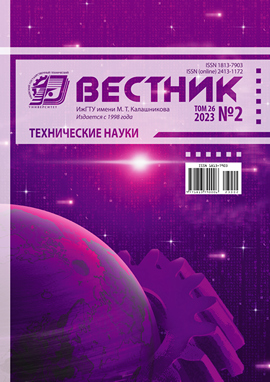Radiofrequency Sensing Method and Algorithm of Inhomogeneous Conductive Structures
DOI:
https://doi.org/10.22213/2413-1172-2023-2-94-102Keywords:
numerical simulation, sounding algorithm, inverse problem, skin effect, medium impedance, inhomogeneous medium, sounding methodAbstract
The paper proposes a method and algorithm for frequency probing of the internal inhomogeneous structure of electrically conductive objects based on the skin effect for diagnostics and control. The essence of the method consists in frequency control of electromagnetic field penetration depth into an electrically conductive object, and according to the measured frequency characteristic of the surface impedance, the profiles of electrophysical parameters characterizing the structural properties of the medium under study. An electrical model of an inhomogeneous medium with distributed RL parameters has been developed on the basis of electrodynamic presentations. The relationship of resistance and inductance linear parameters of the electrical model with the local parameters of the conductive medium results from their relationship with the electrical resistivity and magnetic permeability of the medium. The mathematical model of an inhomogeneous conducting medium is based on the Riccati equation with respect to the impedance characteristics of the medium. The mathematical statement of the probing problem is formulated as an inverse operator problem solution of mathematical physics. A numerical iterative algorithm for inhomogeneous medium frequency sensing based on Tikhonov regularized solution of the inverse problem is proposed. The proposed algorithm can also be extended to probe the internal structure of semiconductor and low-conducting objects containing a capacitive component in the impedance. The results of numerical simulation of the proposed algorithm for various distributions of inhomogeneity in the frequency characteristics of the impedance, measured with a known error, are presented. Solutions to various control and measurement problems in thermophysical applications based on the proposed method are given in the patents of the authors.References
Верлань А. Ф., Сизиков B. C. Интегральные уравнения: методы, алгоритмы, программы. Киев: Наукова думка, 1986. 543 с.
Вычислительные методы решения обратных задач в авиационной технике / Ю. Ф. Гортышов, П. Г. Данилаев, В. А. Костин, Ю. К. Евдокимов, Л. Ю. Фадеева; под общ. ред. д-ра физ.-мат. наук, проф. П. Г. Данилаева. Казань: Изд-во КНИТУ-КАИ, 2021. 392 с.
Evdokimov Yu.K., Denisov E.S., Fadeeva L.Yu. One-dimensional continuously distributed sensors for thermophysical fields: method of measurement, model, and numerical algorithm. Measurement, 186 (2021) 110082; DOI: 10.1016/J. Measurement. 2021. 110082.
Ватульян А. О. Коэффициентные обратные задачи механики. М.: Физматлит, 2019, 272 c.
Алифанов О. М., Артюхин Е. А., Ненарокомов А. В. Обратные задачи в исследовании сложного теплообмена. М.: Янус-К, 2009, 300 с.
Васильева А. Б., Тихонов Н. А. Интегральные уравнения. М.: Физматлит, 2002. 160 с.
Самарский А. А., Вабищевич П. Н. Численные методы решения задач конвекции-диффузии. М.: Либроком, 2015. 248 с.
Evdokimov Yu.K., Martemianov S. (2004) Continuously-distributed sensors for thermophysical fields measurements: main principles and numerical algorithm // Int. J. Mass and Heat Transfer, 2004, no. 47, pp. 329-340.
Евдокимов Ю. К. Распределенные измерительные среды и континуум-измерения: топология, алгоритмы и моделирование // Нелинейный мир. 2007. Т. 5. № 11. C. 639-656.
Евдокимов Ю. К., Фадеева Л. Ю. Математические модели многомерных неоднородных сред с распределенными параметрами // Вестник КГТУ им. А. Н. Туполева. 2020. № 4 (102). С 132-136.
Евдокимов Ю. К., Фадеева Л. Ю. Импеданс длинной линии с микрорельефной неоднородной поверхностью с учетом скин-эффекта // Вестник КГТУ им. А. Н. Туполева. 2019. № 3. С. 169-173.
Raven Malcolm Stuart. Impedance and Skin Effect measurements for a large regular planar copper wire Meander. ActaTechnica CSAV (CeskoslovenskAkademieVed). January 2016.61(1): 91-105.
Corcoran, Joseph & Davies, C.M. & Cawley, Peter & Nagy, Peter. A Quasi-DC Potential Drop Measurement System for Material Testing.IEEE Transactions on Instrumentation and Measurement. 2019. PP. 1-1. doi: 10.1109/TIM.2019.2908509.
Непочаев Ю. Разработка широкополосного радиопоглощающего материала на основе карбида кремния и нитрида алюминия // Современная электроника. 2019. № 2. С. 75-79.
Минько Д. В., Белявин К. Е., Шелег В. К. Теория и практика получения функционально-градиентных материалов импульсными электрофизическими методами: монография. Минск: БНТУ, 2020. 450 с.
Кокцинская Е. М. "Умные" материалы и их применение // Видеонаука: сетевой журнал. 2016. № 1 (1).
Ландау Л. Д. Электродинамика сплошных сред. М.: Физматлит, 2005. 656 с.
Lakhdari Ala Eddine & Cheriet Ahmed & El Ghoul Islam (2019) Skin Effect Based Technique in EC-NDT for Thickness Measurement of Conductive Material. IET Science, Measurement & Technology, 2019, 13. DOI: 10.1049/iet-smt.2018.5322.
Rahman M.S., Huddy J.E., Hamlin A.B. (2022) Broadband mechanoresponsive liquid metal sensors. npj Flex Electron, 2022, 6, 71.
Downloads
Published
How to Cite
Issue
Section
License
Copyright (c) 2023 Юрий Кириллович Евдокимов, Людмила Юрьевна Фадеева

This work is licensed under a Creative Commons Attribution 4.0 International License.


